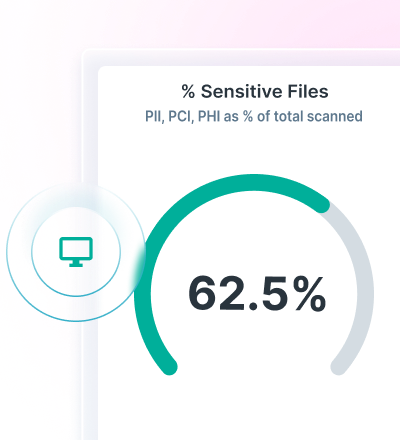Comparing DSPM vs DLP: Key Differences and Use Cases
0 دقائق القراءة

Tim Herr
Organizations are generating, replicating and sharing data faster than ever. Multi-cloud adoption, distributed workforces and AI systems have accelerated how quickly sensitive information moves and where it lives. As a result, security leaders must navigate two urgent questions at once:
- Where is our sensitive data?
- How do we keep it from leaving approved boundaries?
This is where the conversation around DSPM vs DLP has taken center stage. Simply put, Data Security Posture Management (DSPM) provides clarity into data-at-rest, while Data Loss Prevention (DLP) provides control over data-in-motion. When combined with Data Detection and Response (DDR), these technologies create the unified, end-to-end protection organizations need to reduce risk without increasing complexity or slowing innovation.
This article breaks down how DSPM and DLP compare, where each one fits in your security strategy and why the most resilient organizations use them together as part of a modern data security program.
DSPM vs DLP: Key Differences Compared
To understand the relationship between DSPM and DLP, it helps to recognize that they address different stages of data risk. DSPM uncovers unknown data exposure by shining light on where sensitive information lives and how it is stored. DLP prevents data from leaving authorized paths by enforcing consistent policies in real time. When these two capabilities remain separate, gaps emerge. When combined, they create a unified foundation for visibility and control.
Below is a detailed comparison of DLP vs DSPM, including expanded criteria relevant to today’s cloud, AI and multi-environment landscapes.
Feature | DSPM | DLP |
Primary Focus | Continuous visibility and posture improvement | Real-time data movement control |
Environment | Cloud-native across SaaS, PaaS and IaaS | Endpoints, networks, cloud apps and email |
Coverage | Broad discovery across structured and unstructured data | Deep inspection of content during movement |
Compliance | Maps data to regulatory obligations | Enforces compliance policies |
Risk Visibility | Finds blind spots, misconfigurations and oversharing | Flags risky behavior or policy violations |
Scalability | Scales with cloud adoption | Scales with user activity and endpoints |
Data Discovery and Mapping | Automated, continuous mapping | Limited discovery tied to enforcement points |
Policy Enforcement Approach | Preventive posture correction | Reactive blocking or remediation |
Integration Depth Across Cloud Services | Deep native integrations | App connectors and endpoint agents |
Response and Remediation Automation | Fixes misconfigurations | Stops or quarantines risky actions |
User Behavior and Access Insight | Shows access patterns and privilege gaps | Identifies insider risk indicators |
AI and GenAI Exposure Management | Finds AI-generated data and model outputs | Controls uploads to AI tools |
Operational Overhead | Low overhead, analytics driven | Requires ongoing policy management |
Deployment Velocity | Fast to deploy across cloud platforms | Broader implementation across devices |
Cost Considerations | Efficiency gains through visibility | Cost driven by breadth of enforcement |
This comparison shows why organizations have begun moving away from choosing DSPM vs DLP and instead toward unifying the two. DSPM improves your data posture. DLP manages your data’s safe movement. Together, they strengthen each other.
Overview of DSPM and DLP: Key Features and Problems They Solve
DSPM and DLP are complementary, not competing. Each solves different pain points that modern security teams face as data becomes more distributed and dynamic.
Data Loss Protection (DLP)
DLP prevents intentional or accidental data leaks by monitoring how sensitive information moves across email, endpoints, web channels and cloud apps. It inspects content, observes user behavior and enforces policies consistently across the environment.
Key features include:
- Deep content inspection
- Behavioral indicators of insider risk
- Real time coaching for safer decision making
- Enforcement that blocks or quarantines risky actions
DLP solves problems such as data exfiltration, misdirected emails, shadow IT uploads and unsafe file sharing. It protects intellectual property, regulated data and confidential information from leaving through unintended paths.
Data Security Posture Management (DSPM)
DSPM discovers and classifies sensitive data across cloud platforms, providing visibility that traditional tools cannot match. It identifies where data originates, where it moves, how it is stored and who has access to it.
Key features include:
- Automated data discovery
- Classification across structured and unstructured stores
- Misconfiguration detection
- Access rights analysis and privilege visibility
- Risk scoring to help teams prioritize exposure
DSPM solves problems like unknown data sprawl, stale data, misconfigured cloud storage and inconsistent access controls. It is essential for organizations adopting multi-cloud or AI systems where data creation is accelerating quickly. Read more about the best DSPM software in 2025 to learn about the current state of the market.
DSPM Use Cases
DSPM helps security teams uncover risks they did not know existed. These use cases highlight its ability to reduce blind spots and strengthen compliance. Consult our DSPM guide for further details.
Data Discovery and Classification
Organizations often do not know where all their sensitive data resides. DSPM creates a living inventory across cloud services, identifying shadow data, duplicated sets and high-risk locations. This eliminates the guesswork of manual audits.
Compliance and Auditing
DSPM maps data types to regulatory frameworks such as GDPR, HIPAA and PCI. It identifies where sensitive data is stored improperly and highlights access or storage practices that break compliance requirements. This reduces audit effort and improves alignment with global regulations.
Access Governance and Privilege Oversight
DSPM shows which users can access sensitive information and whether those permissions match business needs. It identifies excessive privileges, orphaned accounts and risky sharing patterns that increase exposure.
Misconfiguration Detection Across Cloud Platforms
Cloud misconfigurations remain the leading cause of data breaches. DSPM identifies issues like open storage buckets, public access settings or overly permissive roles that create unnecessary risk.
AI and Shadow AI Visibility
As AI tools generate large volumes of new data, DSPM helps teams understand where AI generated datasets live and how they are being accessed or shared.
DLP Use Cases
DLP protects sensitive data when it is at its most vulnerable: during movement. See our DLP guide for more information.
Preventing Data Leaks
DLP blocks risky actions like attaching sensitive files to personal emails, uploading regulated data to unauthorized services or transferring confidential documents outside approved channels.
Securing Intellectual Property
Advanced DLP identifies and protects proprietary designs, source code, R&D documents and trade secrets. This prevents both accidental exposure and deliberate theft.
Protecting Regulated Data Types
DLP enforces rules around personal information, financial records and healthcare data, ensuring employees cannot move regulated content outside compliant channels. By blocking accidental data loss via productivity tools, it can also assist with regulatory compliance with GenAI.
Detecting Insider Threat Activity
DLP monitors behavioral indicators that signal potential insider threats and flags unusual patterns such as abnormal data transfers or attempts to bypass policies.
Reducing Human Error
DLP reduces day-to-day risks by coaching users in real time when they attempt unsafe actions, helping employees build safer habits organically.
DSPM vs DLP: Direct Comparison
Deployment Considerations
DSPM connects to cloud platforms via API, offering rapid deployment and quick insights. DLP requires broader deployment across endpoints and networks, offering wide enforcement capabilities.
Cost and Resource Requirements
DSPM reduces investigation time by making risk visible. DLP requires continued tuning to reduce alert fatigue and ensure policies reflect business needs. Both capabilities reduce long term operational costs when implemented together.
Maturity and Use Case Alignment
Organizations early in their cloud journey may prioritize DLP first. Those with complex multi cloud environments often see immediate value from DSPM. Mature organizations typically adopt both to gain complete visibility and control.
How to Choose the Right Solution for Your Organization
Choosing between DSPM and DLP depends on where your highest risks originate. If unknown data exposure or cloud misconfigurations are your biggest challenge, choosing a DSPM solution is the best place to begin. If data frequently moves across networks, devices and apps, locating the best DLP software is essential.
However, most organizations soon recognize that DSPM and DLP are not either/or decisions. DSPM shines when uncovering risks in data at rest, while DLP prevents risky movement. Together, they provide a holistic approach to protection.
How DSPM and DLP Can Work Together
Forcepoint’s position is clear: DSPM and DLP are better together.
DSPM discovers sensitive data, classifies it and identifies where risk is growing. DDR monitors how users interact with data in real time. DLP enforces unified policies that protect information across channels.
Together, DSPM, DDR and DLP deliver the approach we call Data Security Everywhere:
- DSPM identifies unknown data and exposure
- DDR monitors data in use and user behavior
- DLP enforces policies for data in motion
This unified approach creates consistent protection across cloud services, endpoints and applications. Instead of isolated tools and conflicting signals, security teams get one continuous workflow that moves from discovery to response to enforcement.
Forcepoint DSPM and DLP Case Study
A global technology company struggled with rapid cloud expansion. Sensitive data was stored in multiple SaaS platforms, and access permissions were inaccurate. The DLP rules they had created years earlier were no longer aligned with their environment.
With Forcepoint DSPM, the organization discovered previously unknown data repositories and identified misconfigured storage settings. The team used these insights to rebuild their DLP rules using accurate, up to date data classifications. The number of policies dropped significantly, and incident volume decreased almost immediately.
Forcepoint’s unified platform helped the company reduce risk, simplify operations and ensure global data compliance across their cloud services and endpoints.
Forcepoint DSPM, DLP and Data Security Cloud
We bring DSPM, DDR and DLP together with Forcepoint Data Security Cloud. This unified platform combines data discovery, data-in-use monitoring and data-in-motion protection in one ecosystem, enabling organizations to cut risk, reduce cost and innovate with confidence.
Security teams gain clarity and control through:
- Automated data discovery
- AI powered classification
- Unified policy enforcement
- Continuous monitoring and remediation
By integrating discovery with enforcement, organizations avoid the gaps created by siloed tools and fragmented visibility. Data stays protected everywhere it travels.
DSPM vs DLP Frequently Asked Questions
What is the difference between DSPM and data protection?
DSPM is one component of data protection focused on cloud visibility and posture. Data protection includes additional capabilities such as DLP, encryption and access controls.
What are the three types of DLP?
The three primary types of DLP include network DLP for data-in-motion, endpoint DLP for data-in-use and storage DLP for data-at-rest.
What is DSPM in data security?
DSPM discovers, classifies and monitors sensitive data across cloud platforms. It identifies misconfigurations, access issues and exposure risk in data at rest.
Can DSPM and DLP be unified?
Yes. DSPM provides the context that DLP needs to enforce policies effectively. Unified data security platforms combine DSPM, DDR and DLP for continuous protection.

Tim Herr
اقرأ المزيد من المقالات بواسطة Tim HerrTim serves as Brand Marketing Copywriter, executing the company's content strategy across a variety of formats and helping to communicate the benefits of Forcepoint solutions in clear, accessible language.
 Gartner®: Market Guide for Data Security Posture Managementعرض تقرير المحلل
Gartner®: Market Guide for Data Security Posture Managementعرض تقرير المحلل
X-Labs
احصل على الرؤى والتحليل والأخبار مباشرةً في الصندوق الوارد










